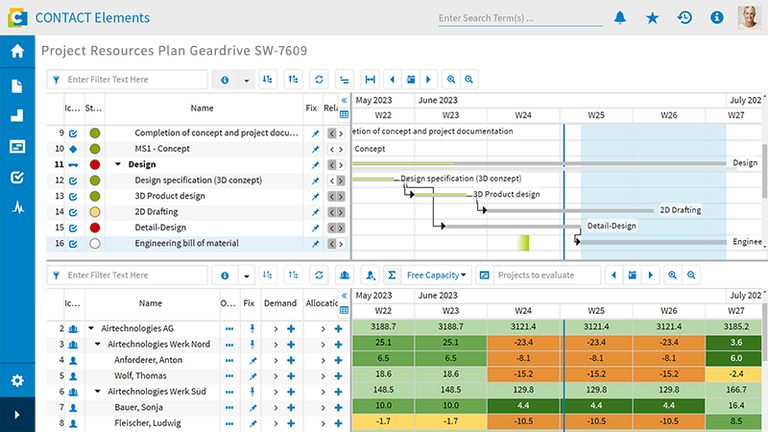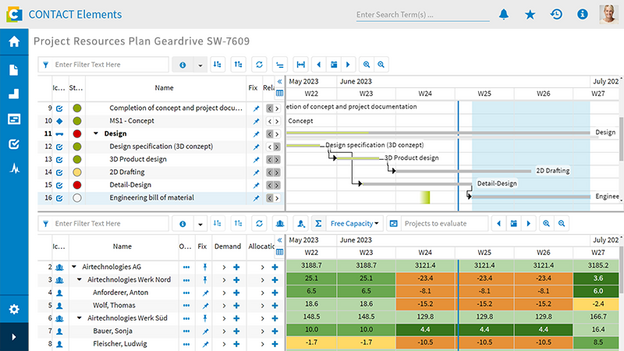Connect effective resource utilization with on-time delivery
Engineering projects require the targeted and on-schedule deployment of limited personnel and material resources. Traditional bottom-up methods rely on detailed task-level planning before capacity utilization becomes apparent – making schedule changes complex and cumbersome. CONTACT Elements Resource takes a more efficient top-down approach: instead of striving for painstaking detail from the outset, you plan your resource deployment strategically at the portfolio level. Learn how resource pools, scenario planning, and multi-project schedules help you maintain oversight, avoid bottlenecks, and sustainably improve resource utilization.
Benefits
- Strategically plan resources across projects and deliver them on time
- Move from top-down rough planning to capacity allocation in detailed planning
- Assign specific capacities from qualification pools

Plan resources strategically – deliver projects on time

Before commencing individual projects, you must determine their realistic launch times and feasibility. The decisive factor is the availability of personnel and material resources. CONTACT Elements Resource Planning enables holistic, strategic resource planning across your entire project portfolio. Within the multi-project plan, you can identify bottlenecks early and assess capacities directly within the project timeline. This ensures reliable project starts, on-time completions, and balanced workloads without peaks or idle time.
Plan resources strategically – deliver projects on time
Before commencing individual projects, you must determine their realistic launch times and feasibility. The decisive factor is the availability of personnel and material resources. CONTACT Elements Resource Planning enables holistic, strategic resource planning across your entire project portfolio. Within the multi-project plan, you can identify bottlenecks early and assess capacities directly within the project timeline. This ensures reliable project starts, on-time completions, and balanced workloads without peaks or idle time.

Before commencing individual projects, you must determine their realistic launch times and feasibility. The decisive factor is the availability of personnel and material resources. CONTACT Elements Resource Planning enables holistic, strategic resource planning across your entire project portfolio. Within the multi-project plan, you can identify bottlenecks early and assess capacities directly within the project timeline. This ensures reliable project starts, on-time completions, and balanced workloads without peaks or idle time.
From top-down rough planning to capacity allocation in detailed planning

Many systems rely on purely bottom-up planning: projects first need to be planned in detail with resources to identify capacity bottlenecks. This makes scenario comparisons and replanning complex and time-consuming. CONTACT Elements Resource Planning takes the opposite approach: start with a high-level plan of your resource needs and gradually refine it in detailed planning, considering availability. Resource pools provide transparency and enable realistic capacity allocation. You identify bottlenecks early, plan proactively, and ensure balanced workloads across your teams.
From top-down rough planning to capacity allocation in detailed planning
Many systems rely on purely bottom-up planning: projects first need to be planned in detail with resources to identify capacity bottlenecks. This makes scenario comparisons and replanning complex and time-consuming. CONTACT Elements Resource Planning takes the opposite approach: start with a high-level plan of your resource needs and gradually refine it in detailed planning, considering availability. Resource pools provide transparency and enable realistic capacity allocation. You identify bottlenecks early, plan proactively, and ensure balanced workloads across your teams.

Many systems rely on purely bottom-up planning: projects first need to be planned in detail with resources to identify capacity bottlenecks. This makes scenario comparisons and replanning complex and time-consuming. CONTACT Elements Resource Planning takes the opposite approach: start with a high-level plan of your resource needs and gradually refine it in detailed planning, considering availability. Resource pools provide transparency and enable realistic capacity allocation. You identify bottlenecks early, plan proactively, and ensure balanced workloads across your teams.
From qualification pools to capacity allocation

As part of your resource planning, you want to identify early how new projects impact the availability of resource groups – like those from engineering, simulation, or quality assurance? With CONTACT Elements Resource Planning, you create a resource structure from qualification pools that aligns with your planning process. You initially plan enterprise-wide at the level of qualification groups and roles. Then, you refine the plan, for example, at departmental or site level, and assign the specific capacities. This way, you maintain an overview even in complex organizations – and manage your capacities with flexibility and precision.
From qualification pools to capacity allocation
As part of your resource planning, you want to identify early how new projects impact the availability of resource groups – like those from engineering, simulation, or quality assurance? With CONTACT Elements Resource Planning, you create a resource structure from qualification pools that aligns with your planning process. You initially plan enterprise-wide at the level of qualification groups and roles. Then, you refine the plan, for example, at departmental or site level, and assign the specific capacities. This way, you maintain an overview even in complex organizations – and manage your capacities with flexibility and precision.

As part of your resource planning, you want to identify early how new projects impact the availability of resource groups – like those from engineering, simulation, or quality assurance? With CONTACT Elements Resource Planning, you create a resource structure from qualification pools that aligns with your planning process. You initially plan enterprise-wide at the level of qualification groups and roles. Then, you refine the plan, for example, at departmental or site level, and assign the specific capacities. This way, you maintain an overview even in complex organizations – and manage your capacities with flexibility and precision.

Resource Planning is tool qualified for ISO 26262 standards
CONTACT Elements is tool-qualified by TÜV Nord in accordance with ISO 26262. In addition to the CONTACT Elements platform, the international technology expert for security has certified the products CIM Database for PLM and Project Office for project management, as well as Resource Planning and a number of other CONTACT Elements software modules. With this certification, TÜV Nord assures that our software fulfills the requirements of ISO 26262 for standards for software tools for the development of safety-relevant properties.
Related Elements
Clearly plan project and program schedules
Create schedules quickly and efficiently with Gantt charts and templates
Specify key deadlines and plan detailed deadlines bottom-up according to specifications
Plan projects from multi-project management to deadline details with optimal views, settings, and procedures
Overview of all project tasks including context information
Use tasks to set the course for a smooth transition from project planning to implementation
Facilitate optimal self-organization for all project participants
Connect reliability with agility and keep track with multi-project mode
Effectively combine project management and project execution
Generate the work breakdown easily from the appropriate project templates
Help managers, planners, and specialist employees to work closely together
Link work breakdown structure to results, resources, and quality planning
Promote agility in projects with hybrid methods
Combine planning reliability and agility effectively
Support self-organized work with task boards
Seamlessly integrate traditional management with agile practices
Accelerate value creation with methods like Scrum
Further information
Would you like to find out more about this topic? Choose one of the following information offers.

